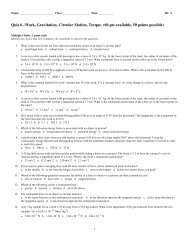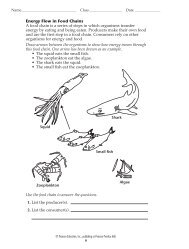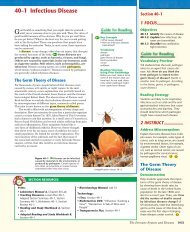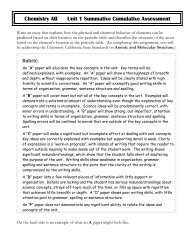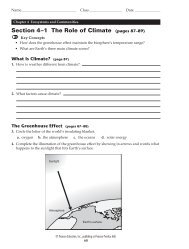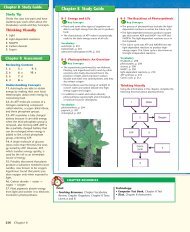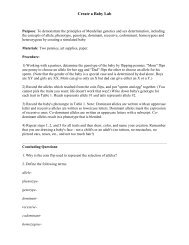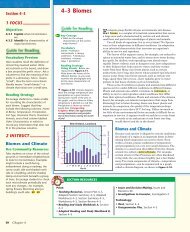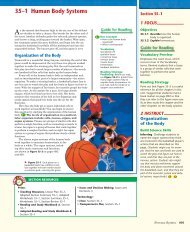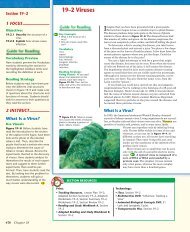35â4 The Senses - Downtown Magnets High School
35â4 The Senses - Downtown Magnets High School
35â4 The Senses - Downtown Magnets High School
Create successful ePaper yourself
Turn your PDF publications into a flip-book with our unique Google optimized e-Paper software.
<strong>The</strong> semicircular canals and the sacs are filled with fluid<br />
and lined with hair cells. As the head changes position, the fluid<br />
in the canals also changes position. This causes the hair on the<br />
hair cells to bend. This action, in turn, sends impulses to the<br />
brain that enable it to determine body motion and position.<br />
Smell and Taste<br />
You may never have thought of it this way, but your sense of<br />
smell is actually an ability to detect chemicals. Chemoreceptors<br />
in the lining of the nasal passageway respond to specific chemicals<br />
and send impulses to the brain through sensory nerves.<br />
Your sense of smell is capable of producing thousands of<br />
different sensations. In fact, much of what we commonly call the<br />
“taste” of food and drink is actually smell. To prove this to<br />
yourself, eat a few bites of food while holding your nose. You’ll<br />
discover that much of the taste of food disappears until you open<br />
your nose and breathe freely.<br />
Like the sense of smell, the sense of taste is a chemical sense.<br />
<strong>The</strong> sense organs that detect taste are the taste buds. Most of<br />
the taste buds are on the tongue, but a few are found at other<br />
locations in the mouth. <strong>The</strong> surface of the tongue is shown in<br />
Figure 35–15. <strong>The</strong> tastes detected by the taste buds are classified<br />
as salty, bitter, sweet, and sour. Sensitivity to these different<br />
categories varies on different parts of the tongue.<br />
Touch and Related <strong>Senses</strong><br />
<strong>The</strong> sense of touch, unlike the other senses you have just read<br />
about, is not found in one particular place. All of the regions of<br />
the skin are sensitive to touch. In this respect, your largest<br />
sense organ is your skin. Skin contains sensory receptors that<br />
respond to temperature, touch, and pain. Not all parts of the<br />
body are equally sensitive to touch, because not all parts have<br />
the same number of receptors. <strong>The</strong> greatest density of touch<br />
receptors is found on your fingers, toes, and face.<br />
35 – 4 Section Assessment<br />
1. Key Concept Name the<br />
five types of sensory receptors<br />
and list where they are found in<br />
the body.<br />
2. Identify the functions of the<br />
cornea, pupil, lens, retina, and<br />
optic nerve.<br />
3. What are the four basic tastes<br />
detected by the tongue<br />
4. Explain why you can’t “taste”<br />
food when you have a bad cold.<br />
5. Critical Thinking Applying<br />
Concepts If you spin around for<br />
a time, the fluid in your semicircular<br />
canals also moves. When you<br />
stop suddenly, you feel as though<br />
you are still moving. Why do you<br />
think you might feel dizzy<br />
(magnification: 86)<br />
Figure 35–15 This colorenhanced<br />
scanning electron micrograph<br />
shows the surface of the<br />
tongue. <strong>The</strong> large pink objects are the<br />
taste buds. Chemoreceptors<br />
found in the taste buds are sensitive<br />
to chemicals in food.<br />
Creative Writing<br />
Imagine that you have to do<br />
without your sense of taste<br />
for one day. How would this<br />
influence your food choices<br />
Write a 3- to 4-paragraph<br />
essay describing how the<br />
absence of this sense organ<br />
would affect your day.<br />
Smell and Taste<br />
Demonstration<br />
Have volunteers taste and try to identify<br />
a variety of different fruit juices<br />
while wearing blindfolds and pinching<br />
their noses shut. (Without sight<br />
cues and the sense of smell, students<br />
will find it difficult to distinguish the<br />
tastes.)<br />
Touch and Related<br />
<strong>Senses</strong><br />
Build Science Skills<br />
Designing Experiments Challenge<br />
students to design an experiment to<br />
determine the distribution of heat<br />
and cold receptors in a small area of<br />
skin on the back of the hand.<br />
3 ASSESS<br />
Evaluate Understanding<br />
Provide students with copies of<br />
Figure 35–13 without the labels.<br />
Have students label each part of the<br />
eye shown in the figure.<br />
Reteach<br />
On the chalkboard or an overhead<br />
transparency, list five general categories<br />
of sensory receptors. Have<br />
students give examples of each category<br />
of receptors at work. (For<br />
chemoreceptors, for example, students<br />
might say smelling a flower or tasting<br />
food.)<br />
Answers will vary. For example,<br />
students might describe how their<br />
sense of taste is affected and how<br />
this, in turn, affects their enjoyment<br />
of food and their appetite.<br />
35 – 4 Section Assessment<br />
1. Pain receptors: everywhere except the brain;<br />
thermoreceptors: skin, body core, hypothalamus;<br />
mechanoreceptors: skin, skeletal<br />
muscles, inner ears; chemoreceptors: nose,<br />
taste buds; photoreceptors: eyes<br />
2. Cornea: helps to focus light; pupil: controls<br />
the amount of light that enters the eye; lens:<br />
adjusts focus for near or far distances; retina:<br />
rod and cone photoreceptors convert light<br />
into electrical impulses; optic nerve: carries<br />
the electrical impulses to the brain<br />
3. <strong>The</strong> four basic taste receptors are receptors<br />
for salty, bitter, sweet, and sour tastes.<br />
4. Because much of the sense of taste is actually<br />
due to interaction with the sense of smell<br />
5. Sensory receptors lag behind the rapid<br />
changes in position.<br />
If your class subscribes to the iText,<br />
use it to review the Key Concepts in<br />
Section 35–4.<br />
Answer to . . .<br />
Figure 35 –14 Loud noises can<br />
damage tiny hair cells and raise the<br />
threshold for detecting sounds.<br />
Nervous System 909



